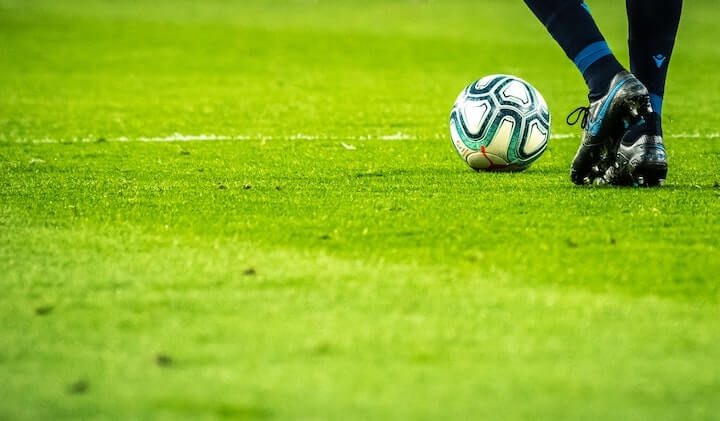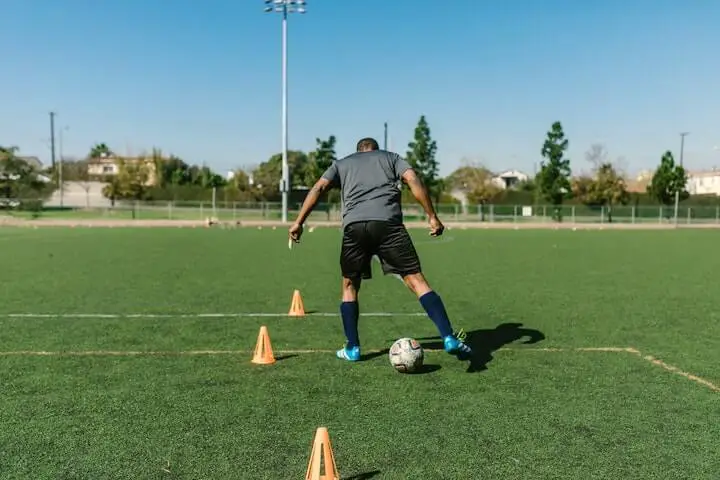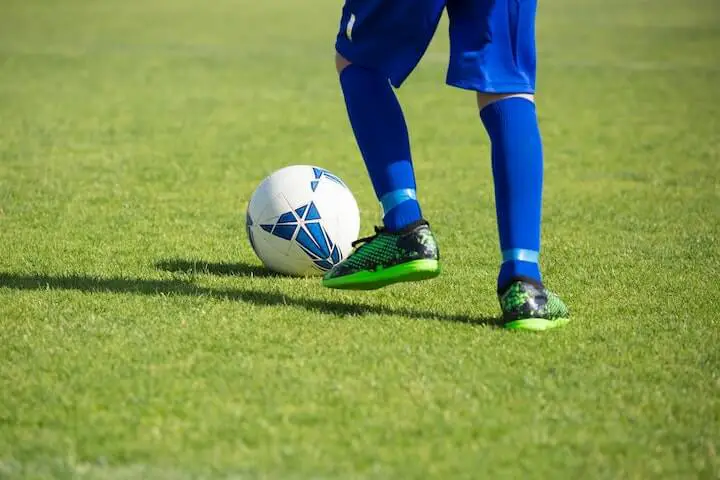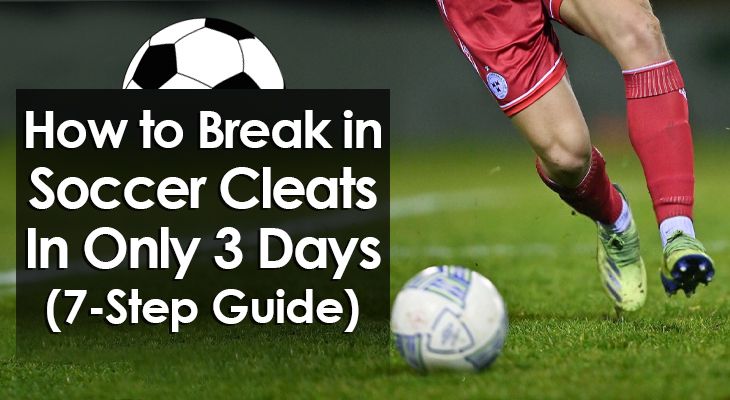How to Break in Soccer Cleats In Only 3 Days (7-Step Guide)
Whether you change your cleats once per season or you’re an avid footwear collector...
There’s nothing quite like getting your hands on a new pair of cleats.
That’s is...
Until you wear them to your first training session and come home with sore and blistered feet!
The dreaded "break in period" is a painful but necessary step to prepare your kicks for game day.
Failing to do so correctly will hurt your performance and may even contribute to an injury.
So in this article, I’ll teach you how to break in soccer cleats in just 3 days.
How to Break in Soccer Cleats
You’ve probably heard that some professionals lace up fresh kicks every other game.
If this is true, you're probably wondering...
"How do they perform at a high level without suffering cramps or developing recurring blisters?"
Well, to put it frankly...
Many professional soccer players have direct access to equipment manufacturers, which gives them the benefit of having their cleats custom-made for maximum comfort and performance.
Until you reach this level, you’ll have to break in your cleats the old-fashioned way.
But with our 7-step guide below, this won’t be a problem for you.

Step 1: Do Your Research
Doing the appropriate research helps ease the breaking in process, ensuring you choose the right cleats for the (1) playing surface, (2) weather, and (3) your foot.
While there’s nothing wrong with a stylish pair of cleats, fashion shouldn’t be the main priority.
The first step is to identify which type of soccer cleat best suits the surface you play on most frequently.
- Firm-ground cleats (FG): The go-to for many modern players, built with rubberized or plastic studs to provide grip on dry to slightly wet grass surfaces.
- Soft-ground cleats (SG): Typically have larger studs or blades, often made from steel, offering excellent stability on wet and muddy soccer fields.
- Artificial-ground cleats (AG): Essential for playing on 3G or 4G synthetic turf, which are some of the most common surfaces found on high school and college grounds.
- Astroturf cleats: Have a cluster of short rubber or plastic nubs, offering freedom of movement on sand or water-based astroturf soccer fields.
Step 2: Decide on Which Cleat Material
If you’re a "one cleat per season" kind of player, leather or firm synthetic materials offers both durability and strength.
Players who change their footwear frequently can enjoy more freedom of choice.
This broadens their options to lighter materials and knitted varieties.
Whatever fabric, there are plenty of great options from leading cleat manufacturers, including:
- Nike Phantom series (all weather synthetic)
- Adidas Predator Pulse (premium K leather)
- Puma Ultra (synthetic material featuring Kevlar yarns)
- New Balance Furon (combination of leather and knitted synthetic)
- Adidas Copa Mundial (K leather)
Reminder: Check Your Size
Never underestimate the importance of correct sizing when selecting your cleats.
Although many of us now buy our cleats online, it’s important to know your exact size and how it aligns with your chosen shoe.
And remember that not all brands follow the same size and shape guide...
If you’re switching to a new one, be sure to try them on first.
If possible, head down to your local sports store wearing gameday socks and try on your favorite cleats to gauge the right size for your feet.
You’re not obliged to buy cleats from the store so if they’re cheaper online, get yourself a bargain.
Unfortunately, some cleat designs simply don’t suit certain foot shapes.
If you opt for ill-fitting cleats, they may cause discomfort or injury, and are likely to hamper your first touch, ball control, and ability to strike the ball cleanly.
Unless you can afford to have a custom pair made, you may be better off moving on to your second choice.

Step 3: Invest in Good Insoles
Custom insoles are perhaps the best way to fast-track the break in phase.
They add instant comfort and support in the areas you need them most: the heel and arch.
Insoles contain built-in arch supports, preventing strain or an over-collapse, which are two of the main stresses when sporting new footwear.
They also have heel cups for sinking the back of your foot into, helping you avoid that numbing pain of a rock-hard cleat sole.
Since the sole of the cleat is one of the most important parts to break in, a custom insole expedites the entire process.
Aside from offering support and comfort, good insoles have plenty of long-term benefits.
Custom varieties align with the natural contours of your feet, limiting excessive movement inside the shoe and helping maintain its shape.
They also act as shock absorbers, protecting your feet from the constant pounding during practice and games.
Custom insoles influence your gait and should be sourced from a medical professional.
Consult your GP, physiotherapist, or podiatrist to inquire about having a pair made.
The great thing about custom insoles is that they are transferable to different types of footwear.
However, due to the high-impact nature of soccer, it may be better to reserve a set exclusively for your cleats.
Step 4: Take a Walk
Once you’ve secured the right pair, it’s time to start day 1 of breaking them in.
First and foremost, slip on your cleats, lace them up, and take a walk around your backyard or local park.
It can be beneficial to loosen the laces in the beginning, giving the cleat enough flexibility to adjust and adapt to your foot.
As the cleats expand, you can start tightening the laces to find the sweet spot and most comfortable fit.
Walk around for 15 to 20 minutes at a time then give your feet a break by taking the cleats off.
If you feel that the cleats are breaking in quicker than you thought, consider testing out some dynamic movements, like jumping, turning, and rapidly changing direction.
Many modern cleats are laceless, making them far tighter than laced varieties and may take a little longer to get ready.
Use a shoe stretcher to ensure they aren’t overly restrictive but avoid wearing them for too long in case you develop blisters.
Reminder: Wear the Right Socks
It’s important to wear socks when you’re breaking in the cleats.
This not only provides cushioning to the feet, but it also mimics what you’ll wear when playing.
If your cleats are too tight, wear an extra pair of socks underneath to help stretch them out.
Compression socks are an excellent choice for your base layer.
The extra pressure facilitates oxygen-rich blood flow to the feet and legs, minimizing inflammation and achy pain.
For the outer layer, opt for a cushioned sock with grip pads on the bottom sole.
The extra grip helps secure your foot in place, reducing friction and helping prevent chafing or blisters.
Reminder: Bring Spare Shoes
If you plan to break in your cleats at the training ground or local park, be sure to bring spare shoes to give your feet a rest periodically.
There's no use breaking in your cleats for 3 days if your feet are going to be too sore to wear them on the 4th or 5th day.
Although we recommended wearing the cleats for 15 to 20 minutes at a time, this is just a guide.
If you experience discomfort before then, listen to your body, and give your feet a break immediately.

Step 5: Train Using Lubricant
On day 2, you can increase your workload in the cleats, as they’ll already be partially broken in.
Plan out a training session and hit the field with your new cleats.
Incorporate drills and exercises that involve explosive movements, jumping, changing direction, first touch, and striking the ball.
That way, you’ll have covered all the main actions you’re likely to perform in a game.
However, make sure to take an older pair with you in case your feet start hurting.
A great tip to protect your feet in this instance is to apply petroleum jelly, like Vaseline, to the main areas of friction between your foot and the inside of the shoe.
By adding lubricant between the feet and inner cleats, you reduce the dry contact that causes blistering.
Another benefit is that it can soften the leather and polymers, speeding up the breaking-in process.
Step 6: Stretch the Uppers
The upper is the section of material that forms the front part of the cleat.
It covers the toes, top of the foot, either side of the foot, and the back side of the heel.
In many cases, the upper is made from several pieces of fabric, stitched together firmly for stability. You can tenderize or stretch these sections to ensure a more comfortable fit.
With that said...
It’s important to exercise caution when stretching the uppers, especially for non-leather cleats.
Essentially, the goal is to make the material more supple and stretchy, rather than forcefully increasing its size.
Placing too much stress on the material is likely to cause a tear or some structural damage.
We recommend two effective ways to stretch out the uppers:
a. By Hand and Foot
The most reliable way to stretch out the uppers is by wearing your cleats intermittently after buying them.
You can also open up the laces and use your hand to gently stretch out the material.
Stuff the cleat cavity with a shoe tree or scrunched-up newspaper to help train the fabric.
Then leave the stuffed cleats in a dry room overnight.
If your cleats are leather, consider using a stretch spray to improve their flexibility and comfort.
These sprays penetrate the exterior of the leather before loosening the inner fibers, making the leather easier to stretch.
Before applying any such chemicals to your cleats, always read the label.
Some of these sprays may dry out leather quicker, which may reduce the lifespan of your cleats.
b. Warm Water Technique
Although this approach is effective for leather cleats, it can cause damage to the adhesives, plastics, and rubber materials holding them together.
If you’re a one pair of cleats per seasons person, this may not be the right approach for you.
Here's what to do...
1. The first step is to fill a bathtub or basin with 90 to 100 degree (Fahrenheit) water to below ankle height (water shouldn’t leak into your cleat).
2. Next, lace up your cleats as normal (with your socks on), then step into the water to loosen the uppers, allowing you to stretch and conform them to the shape of your foot.
3. Wait approximately 10 minutes before stepping out of the basin.
4. Spend the next 10 to 15 minutes running around and kicking a ball -- which rinses out the immediate soakage and reshapes the cleat’s structure.
5. Allow the cleats to dry naturally or stuff them with newspapers overnight to complete the process.
Step 7: Dry Your Cleats Properly
At the end of day 2, after completing the above, your cleats are a single step away from being ready for their competitive debut.
Drying your cleats correctly not only completes the breaking in period, but it also helps extend the life of your footwear, preventing the material from cracking and wearing down quickly.
It’s a habit that you should keep up for all of your cleats going forward.
After cleaning or wetting, dry out your cleats by:
- Wiping them down with a dry and clean cloth on the inside and outside.
- Loosening the laces (improves airflow and reduces damage to the exterior as it contracts and dries).
- Removing the insoles to ensure maximum exposure to the air.
- Hanging the cleats on a clothesline or placing them in an open dry space where they have maximum access to fresh air.
After air drying for a couple of hours, stuff the cleat cavity with newspaper and leave them for several more hours.
When the cleats have dried, you can sprinkle them with bicarbonate soda to mask any smells and keep them fresh.
Although some players resort to using the washing machine, tumble dryer, and heaters to expedite the process, this can damage the cleats in the long run.

Conclusion
Now that you know how to break in soccer cleats the right way, you can apply the technique to all your future purchases.
We hope our tips will help you maintain your cleats for longer, stay free of troublesome blisters, and perform at your best every time you lace up.

